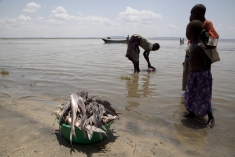Lake Turkana At Risk: FAQ
Lake Turkana is a miraculous natural wonder that supports vibrant, unique cultures and remarkable biodiversity. Turkana is the largest permanent desert lake in the world, and Africa’s fourth largest lake. Because its main water source is controlled by Ethiopia, which is rapidly developing its rivers for hydropower and irrigation, Lake Turkana is now at risk of ecological collapse. The Omo River, which originates in Ethiopia, accounts for about 90% of the lake’s inflow. Developments now underway in the Lower Omo Valley will dramatically reduce the amount of water flowing into the lake, leading to a major drop in its level, a collapse of local livelihoods, and increased conflict in the Horn of Africa. Here are some facts you should know.
Q: Isn’t Lake Turkana protected already?
A: Lake Turkana National Parks are a UNESCO World Heritage Site, but neither designation offers the kind of protection that is required to prevent a “hydrological collapse” from upstream projects. In recent years, the World Heritage Centre has recommended that Lake Turkana be listed as “World Heritage In Danger,” including most recently in 2014, but the World Heritage Committee failed to do so. During the 2014 meeting, the Governments of Ethiopia and Kenya promised to undertake a “strategic environmental impact assessment” (SEIA) to look at how the Omo developments will affect Lake Turkana (the say it will be completed by February 2015). Ethiopia also invited World Heritage to visit the Lower Omo developments. Based on the promise of the SEIA and the field visit, the World Heritage Committee voted to not list the lake as “in danger.” As of Feb. 2015, there was no further development on the SEIA, but an invitation for a field visit to the dam had been received by the Committee.
Q: What is special about the lake’s wildlife?
A: The lake supports about 50 different species of fish, including 11 “endemic” species (meaning they are only found in that location). The lake basin also supports hundreds of species of birds, including those native to Kenya as well as migrating species. Over 350 species of aquatic and terrestrial birds are known in this region, which is recognized by BirdLife International as an Important Bird Area, and a priority for conservation. The lake is home to the world's largest population of Nile crocodiles, which survive on giant perch. Both the perch and the crocodiles came here more than 11,000 years ago, when the lake’s water level was high enough to overflow into the Nile River, allowing fish and crocodiles access.
Q: Who lives in the area?
A: About 300,000 people live near the lake, and have become masters of wresting sustenance from the harsh landscape. Most Turkana communities are highly dependent on the lake for their food crops, raising livestock, and fishing. If Lake Turkana dries up from Ethiopia’s dams and diversions, 300,000 Kenyans could see their livelihoods dry up too. The people who live around Lake Turkana were neither informed of the projects’ impacts nor consulted on their priorities. Hear what people around the lake have to say about the impacts of these projects on their lives (video).
Q. How much water will Ethiopia’s projects use?
As of Jan. 2015, the Gibe III Dam’s reservoir has started to fill. This will take up to three years. During this time, the river’s yearly flow will drop as much as 70%, and the lake level will drop by about two meters.
The irrigation projects will water some 330,000 hectares of state-owned plantations and private concessions. Most of this will be planted in very thirsty crops, such as cotton and sugar. According to Dr. Sean Avery, the lead hydrologist investigating these impacts, Ethiopia’s state-run Kuraz sugar plantation alone will result in one-third less water reaching Lake Turkana – an amount equivalent to the water use of 40 cities the size of Nairobi. If all areas identified for cultivation are developed, they could take almost half of the Omo River inflow to Lake Turkana. (So far, about 30,000 ha have been developed.) If current plans to create new plantations move forward, the lake could drop from 16 to 22 meters. The average depth of the lake is just 31 meters.
Q. What is Kenya’s role in the project?
A. While these projects threaten the economy of the Turkana region, a large share of Gibe III’s electricity will be sold to grid-connected consumers in Kenya. A power purchase agreement outlining the terms of electricity sales from the dam to Kenya was signed by the two governments in 2006, but has never been made public. There is no known agreement on the use of the Omo-Turkana waterway between the two countries.



